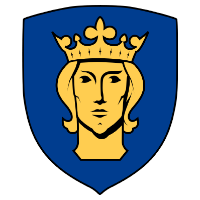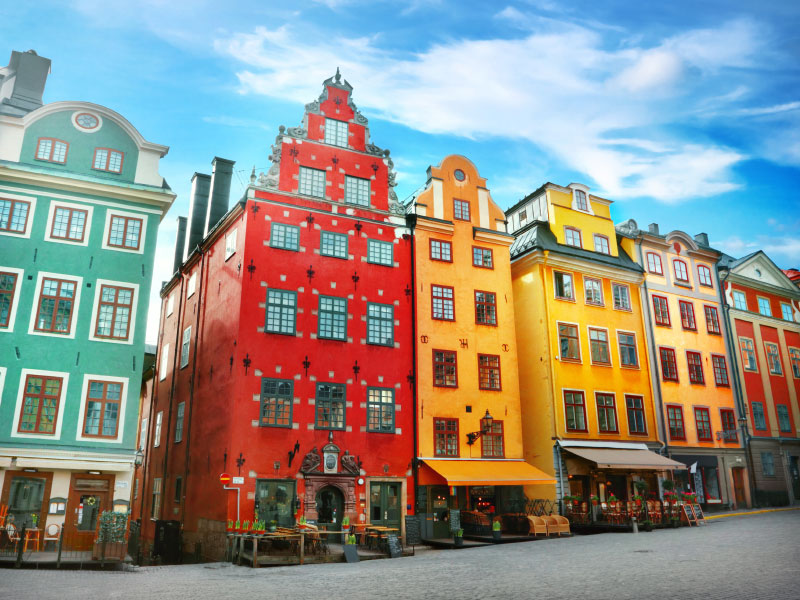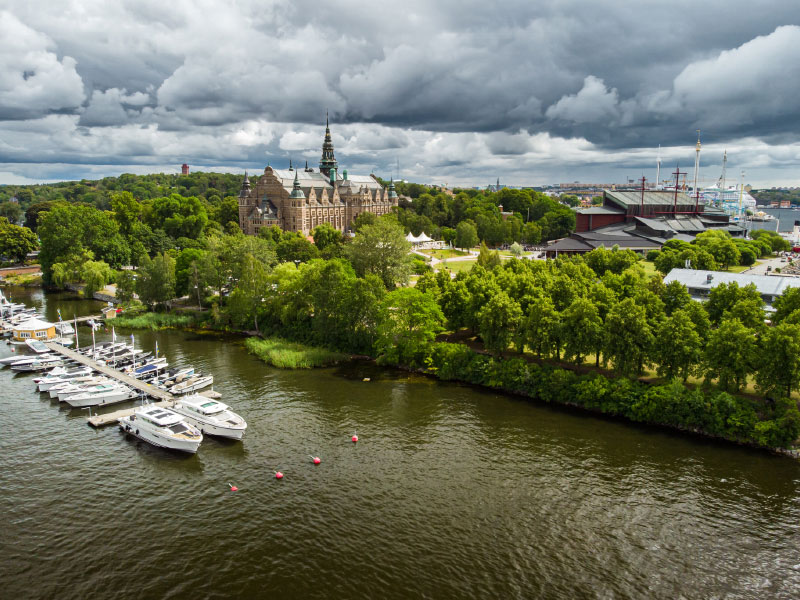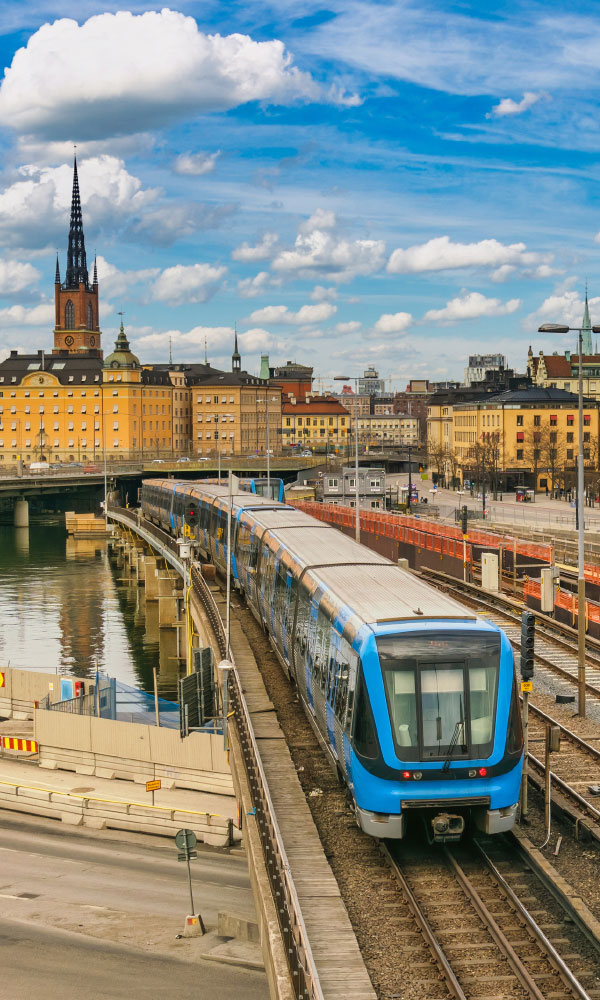Travelling to Stockholm?
Are you heading to Stockholm on a work trip? Get to know the city better in our comprehensive guide for business travellers.
Celebrated as the economic centre of Sweden – the region alone accounts for around a third of the country’s GDP – the city of Stockholm stretches across a constellation of islands on the eastern coast. With 30% of the central area made up of waterways, rivers and streams curve and twist beside Stockholm’s streets, bringing freshwater life to the modern metropolis.
In this article we take a deeper look into the city dubbed the “Venice of the North” as a business travel destination. We run through the best ways to get to and from the city, explore the local business culture and etiquette, and offer up our top 3 things to do in and around Stockholm if you find yourself with some free time.
Stockholm Fact File

Stockholm coat of arms depicting Swedish king Saint Eric
Languages
Swedish and widespread fluency in English
Currency
Swedish Krona (kr)
Avg. Temperatures
Spring (Mar-May) = 6.2 °C (43.3 °F)
Summer (Jun-Aug) = 22.1 °C (71.8 °F)
Autumn (Sep-Nov) = 11.3 °C. (52.4 °F)
Winter (Dec-Feb) = 1.5 °C (34.7 °F)
Getting To Stockholm
By Air
Stockholm Arlanda Airport (ARN): Arlanda is the largest and busiest airport in the Stockholm region and is the primary international gateway to the city. Stockholm Bromma Airport (BMA), though closer to the city centre, primarily serves domestic and regional flights and is a convenient choice for those traveling within Sweden and to nearby Scandinavian destinations.
By Sea
Several ferry companies operate routes to Stockholm from nearby cities and countries. These ferries are a popular means of transportation, especially from neighbouring Baltic nations, with popular routes including those between Stockholm and Helsinki, Tallinn, and Riga. Värtahamnen, situated in the city centre, is one of the main ferry terminals for international travellers.
By Car
Denmark and Norway are the only two countries from which you can get to Stockholm by land-only routes. From Denmark, head over the Øresund Bridge connecting Copenhagen and Malmö before driving 610km north. From Norway, you can enter Sweden at the Svinesund Bridge near Halden and follow the E6 and E4 highways east to reach Stockholm.
Business Culture & Etiquette
A good work-life balance is highly valued in Stockholm and across Sweden. Employees are encouraged to work efficiently during office hours, and excessive overtime is not the norm. Many companies in Sweden have flat hierarchies to encourage open communication between employees and management – work is collaborative, and leaders are expected to involve their teams in the decision-making process.
When meeting someone for the first time or in a formal context, a handshake is the standard greeting. In more informal settings, it is common to greet with a simple wave and a friendly “Hej!” (Hello) or “Hej då!” (Goodbye). Swedes also tend to use first names when addressing each other, even in professional settings, and respecting personal space is extremely important.
If you are invited to someone’s home, it is customary to remove your shoes before entering. If you have been invited for dinner, wait for the host to start the meal before you begin eating.
A few of our other top etiquette tips:
- You can say “Tack för maten” (Thank you for the meal) to show appreciation for your dinner.
- Swedes are known for their orderly queuing and cutting in line is frowned upon.
- Avoid standing too close to someone you’re not well-acquainted with to respect their personal space.
Crime & Safety
Stockholm is generally considered a safe city, with a low crime rate compared to many other international cities. However, the risk of terrorism has been steadily increasing across Sweden over the past few years, with the Swedish Security Service raising the terrorist threat level from level 3 (‘elevated’) to level 4 (‘high’) in August 2023 following an internal assessment.
Though violent crime is very rare, be wary of pickpockets in popular tourist destinations. The old town area of Gamla Stan and the bustling metropolitan centre of Norrmalm are among the safest neighbourhoods in the city, and using public transport to travel between them is extremely safe. it is also worth noting that temperatures in the winter can drop below freezing, so dress sensibly and expect to face snowstorms.
Here are a few of our other top safety tips:
- Though many Swedes speak English, learning a few basic Swedish phrases can prove helpful.
- The emergency phone number in Sweden is 112 for police, medical assistance, or fire emergencies.
- Uber is not available in Stockholm, but you can use authorised taxi services.
Getting Around Stockholm
Train (Pendeltåg)
Commuter trains connect the city centre with the surrounding suburbs and towns. They are operated by SL (Storstockholms Lokaltrafik) and can be accessed as a pay-as-you-go service using the SL app or contactless payment card.

Bicycles (Cyklar)
Stockholm is a cycle-friendly city and has an extensive network of bike lanes and bike-sharing programs. Gamla Stans Cykel, Cykelstallet, and Stockholm Adventures offer rental bikes all year round and virtually every public space offers bicycle parking space.

Metro (Tunnelbana)
First opened in 1950, the Stockholm Metro is one of the most efficient ways to get around the city. It consists of three main lines (Red, Green, and Blue) and several smaller branches. All three lines and seven routes interchange at T-Centralen station.

Tram (Spårvagn)
The the Stockholm tram network is not as extensive as the train routes, it remains a convenient way to explore specific parts of the city, especially Djurgården and western districts. Up to date schedules can be checked through the SL website or app.
Top 3 Things To See Or Do In Stockholm
If you find yourself with a bit of free time on your business trip, Stockholm is a beautiful and vibrant city with a rich history and plenty to explore. Here’s our top 3 recommendations…

1. Gamla Stan (Old Town)
Gamla Stan is the historic heart of Stockholm and one of the best-preserved medieval city centres in Europe. Its charming narrow streets, colourful architecture, and cobblestone alleys are a delight to explore. Key highlights in Gamla Stan include the Royal Palace (Kungliga Slottet), Storkyrkan (Stockholm Cathedral), and the Nobel Museum. Don’t forget to stroll along Västerlånggatan and Österlånggatan, the two main streets of Gamla Stan, and stop for a coffee or a meal at one of the many cosy cafés and restaurants.

2. Vasa Museum
The Vasa Museum (Vasamuseet) is a world-famous venue that houses the remarkably well-preserved warship Vasa, which sank on its maiden voyage in 1628. The ship was salvaged in the 1960s and is on display in this museum. You can learn about the history of the Vasa and Sweden’s naval heritage and is an absolute must-visit for history and maritime enthusiasts.

3. Djurgården
Djurgården is an island in the heart of Stockholm and a haven for culture, history, and natural beauty. Some of the city’s top attractions are located here, including the Skansen Open-Air Museum, where you can experience Swedish history and culture, and Gröna Lund, an amusement park. Djurgården is also home to numerous walking and biking paths, making it an excellent place to enjoy a leisurely day outdoors.
In Conclusion
Stockholm is a great destination for business travellers, blending rich cultural heritage with cutting-edge modernity. The so-called “Venice of the North” is well connected by land, sea and air, while the city’s user-friendly public transport system and extensive cycle routes make getting around the city a breeze.
Understanding Swedish business culture, from the importance of a healthy work-life balance to the preference of many businesses to opt for a flat, consensus-building hierarchal structure, is key. Moreover, maintaining proper etiquette – whether that be addressing colleagues by their first names or learning short phrases such as “Hej då” (goodbye) – will go a long way towards ensuring your business meetings go smoothly.
So, whether you’re exploring the historic streets of Gamla Stan or sealing a crucial deal in one of the city’s many modern business hubs, Stockholm’s charm will no doubt leave a lasting impression once you return home from your trip.
Related Articles
Artificial Intelligence in Business Travel
From intuitive chatbots to predictive analytics, AI offers businesses significant efficiencies and raises important questions around data privacy, ethics, and sustainability. At Gray Dawes Travel, we’re embracing AI, but understand that it needs to be done responsibly. In this article, we explore the negative impact of AI, how we, as an organisation, can mitigate these impacts, and look to the future of the technology and how it might enhance travel.
A Day In The Life of the Head of IT Operations
It wouldn’t be too outlandish to suggest that Colin’s IT career started in the seaside arcades of Margate. Now Head of IT Operations at Gray Dawes, Colin has had a long and varied career defined by the rapidly changing face of technology. In this article, we chat with Colin about his day-to-day responsibilities as the Head of IT Operations at Gray Dawes Travel, his ultimate career highlights, and what it takes to be a leader in the industry.
How to Pack Like a Business Travel Pro
After a long journey, there’s nothing more frustrating than needing one item from your suitcase, only to discover it buried beneath everything else. Business travel is full of tight schedules, back-to-back meetings, and unfamiliar cities to navigate, so ensuring that...
CALL US
08448 553700
+44 (0) 1206 716111 (if outside the UK)
EMAIL US
ALWAYS HERE
Mon – Sun, 24 hours a day
LET’S TALK
Fill in the form below and we’ll get back to you as soon as we can.





